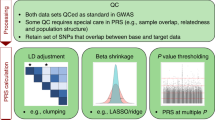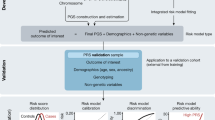Abstract
The brisk discovery of novel inherited disease markers by genome-wide association (GWA) studies has raised expectations for predicting disease risk by analysing multiple common alleles. However, the statistics used during the discovery phase of research (such as odds ratios or p values for association) are not the most appropriate measures for evaluating the predictive value of genetic profiles. We argue that other measures — such as sensitivity, specificity, and positive and negative predictive values — are more useful when proposing a genetic profile for risk prediction.
This is a preview of subscription content, access via your institution
Access options
Subscribe to this journal
Receive 12 print issues and online access
$189.00 per year
only $15.75 per issue
Buy this article
- Purchase on Springer Link
- Instant access to full article PDF
Prices may be subject to local taxes which are calculated during checkout

Similar content being viewed by others
References
Manolio, T. A., Brooks, L. D. & Collins, F. S. A HapMap harvest of insights into the genetics of common disease. J. Clin. Invest. 118, 1590–1605 (2008).
Rockhill, B., Newman, B. & Weinberg, C. Use and misuse of population attributable fractions. Am. J. Public Health 88, 15–19 (1998).
Thomas, G. et al. Multiple loci identified in a genome-wide association study of prostate cancer. Nature Genet. 40, 310–315 (2008).
Zheng, S. L. et al. Cumulative association of five genetic variants with prostate cancer. N. Engl. J. Med. 358, 910–919 (2008).
Weedon, M. N. et al. Combining information from common type 2 diabetes risk polymorphisms improves disease prediction. PLoS Med. 3, e374 (2006).
Kathiresan, S. et al. Polymorphisms associated with cholesterol and risk of cardiovascular events. N. Engl. J. Med. 358, 1240–1249 (2008).
Coates, R. J., Khoury, M. J. & Gwinn, M. Five genetic variants associated with prostate cancer. N. Engl. J. Med. 358, 2738; author reply 2741 (2008).
Gartner, C. E., Barendregt, J. J. & Hall, W. D. Five genetic variants associated with prostate cancer. N. Engl. J. Med. 358, 2738–2739; author reply 2741 (2008).
Janssens, A. C. & van Duijn, C. M. Five genetic variants associated with prostate cancer. N. Engl. J. Med. 358, 2739; author reply 2741 (2008).
Dehghan, A. et al. Association of three genetic loci with uric acid concentration and risk of gout: a genome-wide association study. Lancet 372, 1953–1961 (2008).
Maller, J. et al. Common variation in three genes, including a noncoding variant in CFH, strongly influences risk of age-related macular degeneration. Nature Genet. 38, 1055–1059 (2006).
Janssens, A. C. & van Duijn, C. M. Genome-based prediction of common diseases: advances and prospects. Hum. Mol. Genet. 17, R166–R173 (2008).
Haddow, J. & Palomaki, G. in Human Genome Epidemiology (eds Khoury, M. J., Little, J. & Burke, W.) 217–233 (Oxford Univ. Press, Oxford, 2003).
Pepe, M. S. The Statistical Evaluation of Medical Tests for Classification and Prediction (Oxford Univ. Press, New York, 2003).
Ioannidis, J. P. Why most discovered true associations are inflated. Epidemiology 19, 640–648 (2008).
Kraft, P. Curses — winner's and otherwise — in genetic epidemiology. Epidemiology 19, 649–651; discussion 657–658 (2008).
Davey Smith, G. et al. Genetic epidemiology and public health: hope, hype, and future prospects. Lancet 366, 1484–1498 (2005).
Khoury, M. J. et al. The continuum of translation research in genomic medicine: how can we accelerate the appropriate integration of human genome discoveries into health care and disease prevention? Genet. Med. 9, 665–674 (2007).
Hunter, D. J., Khoury, M. J. & Drazen, J. M. Letting the genome out of the bottle — will we get our wish? N. Engl. J. Med. 358, 105–107 (2008).
Grosse, S. D. & Khoury, M. J. What is the clinical utility of genetic testing? Genet. Med. 8, 448–450 (2006).
Ware, J. H. The limitations of risk factors as prognostic tools. N. Engl. J. Med. 355, 2615–2617 (2006).
Pepe, M. S., Janes, H., Longton, G., Leisenring, W. & Newcomb, P. Limitations of the odds ratio in gauging the performance of a diagnostic, prognostic, or screening marker. Am. J. Epidemiol. 159, 882–890 (2004).
Wald, N. J., Hackshaw, A. K. & Frost, C. D. When can a risk factor be used as a worthwhile screening test? BMJ 319, 1562–1565 (1999).
Kolata, G. New take on a prostate drug, and a new debate. New York Times [online], http://www.nytimes.com/2008/06/15/health/15prostate.html (15 Jun 2008).
Thompson, I. M. et al. The influence of finasteride on the development of prostate cancer. N. Engl. J. Med. 349, 215–224 (2003).
Lucia, M. S. et al. Finasteride and high-grade prostate cancer in the Prostate Cancer Prevention Trial. J. Natl Cancer Inst. 99, 1375–1383 (2007).
Wilt, T. J., MacDonald, R., Hagerty, K., Schellhammer, P. & Kramer, B. S. 5-alpha-reductase inhibitors for prostate cancer prevention. Cochrane Database Syst. Rev. 2, CD007091 (2008).
Linn, M. M., Ball, R. A. & Maradiegue, A. Prostate-specific antigen screening: friend or foe? Urol. Nurs. 27, 481–489; quiz 490 (2007).
Lim, L. S. & Sherin, K. Screening for prostate cancer in U.S. men ACPM position statement on preventive practice. Am. J. Prev. Med. 34, 164–170 (2008).
JBS 2: Joint British Societies' guidelines on prevention of cardiovascular disease in clinical practice. Heart 91 (Suppl. 5), v1–v52 (2005).
Willey, S. C. & Cocilovo, C. Screening and follow-up of the patient at high risk for breast cancer. Obstet. Gynecol. 110, 1404–1416 (2007).
Schiffman, M., Castle, P. E., Jeronimo, J., Rodriguez, A. C. & Wacholder, S. Human papillomavirus and cervical cancer. Lancet 370, 890–907 (2007).
Yang, Q., Khoury, M. J., Coughlin, S. S., Sun, F. & Flanders, W. D. On the use of population-based registries in the clinical validation of genetic tests for disease susceptibility. Genet. Med. 2, 186–192 (2000).
Gail, M. H. & Pfeiffer, R. M. On criteria for evaluating models of absolute risk. Biostatistics 6, 227–239 (2005).
Easton, D. F. et al. Genome-wide association study identifies novel breast cancer susceptibility loci. Nature 447, 1087–1093 (2007).
Eeles, R. A. et al. Multiple newly identified loci associated with prostate cancer susceptibility. Nature Genet. 40, 316–321 (2008).
Fisher, B. et al. Tamoxifen for prevention of breast cancer: report of the National Surgical Adjuvant Breast and Bowel Project P-1 Study. J. Natl Cancer Inst. 90, 1371–1388 (1998).
Pharoah, P. D., Antoniou, A. C., Easton, D. F. & Ponder, B. A. Polygenes, risk prediction, and targeted prevention of breast cancer. N. Engl. J. Med. 358, 2796–2803 (2008).
Gail, M. H. et al. Weighing the risks and benefits of tamoxifen treatment for preventing breast cancer. J. Natl Cancer Inst. 91, 1829–1846 (1999).
Topol, E. J., Murray, S. S. & Frazer, K. A. The genomics gold rush. JAMA 298, 218–221 (2007).
Caskey, C. in The Code of Codes: Scientific and Social Issues in the Human Genome Project (eds Kevles, D. & Hood, L.) 112–135 (Harvard Univ. Press, Cambridge, Massachusetts, 1992).
Bruzzi, P., Green, S. B., Byar, D. P., Brinton, L. A. & Schairer, C. Estimating the population attributable risk for multiple risk factors using case–control data. Am. J. Epidemiol. 122, 904–914 (1985).
Cole, P. & MacMahon, B. Attributable risk percent in case–control studies. Br. J. Prev. Soc. Med. 25, 242–244 (1971).
Yeager, M. et al. Genome-wide association study of prostate cancer identifies a second risk locus at 8q24. Nature Genet. 39, 645–649 (2007).
Qi, L. et al. Adiponectin genetic variability, plasma adiponectin, and cardiovascular risk in patients with type 2 diabetes. Diabetes 55, 1512–1516 (2006).
Frayling, T. M. Genome-wide association studies provide new insights into type 2 diabetes aetiology. Nature Rev. Genet. 8, 657–662 (2007).
Zeggini, E. et al. Replication of genome-wide association signals in UK samples reveals risk loci for type 2 diabetes. Science 316, 1336–1341 (2007).
Lu, Q. & Elston, R. C. Using the optimal receiver operating characteristic curve to design a predictive genetic test, exemplified with type 2 diabetes. Am. J. Hum. Genet. 82, 641–651 (2008).
Janssens, A. C. et al. Predictive testing for complex diseases using multiple genes: fact or fiction? Genet. Med. 8, 395–400 (2006).
Pencina, M. J., D'Agostino, R. B. Sr, D'Agostino, R. B. Jr & Vasan, R. S. Evaluating the added predictive ability of a new marker: from area under the ROC curve to reclassification and beyond. Stat. Med. 27, 157–172; discussion 207–212 (2008).
Cook, N. R. Use and misuse of the receiver operating characteristic curve in risk prediction. Circulation 115, 928–935 (2007).
Acknowledgements
This work was supported in part by National Institutes of Health grants CA098233 and DK58845.
Author information
Authors and Affiliations
Corresponding author
Supplementary information
Supplementary information S1 (box)
Multi-locus risk models and the risk of overfitting (PDF 229 kb)
Related links
Rights and permissions
About this article
Cite this article
Kraft, P., Wacholder, S., Cornelis, M. et al. Beyond odds ratios — communicating disease risk based on genetic profiles. Nat Rev Genet 10, 264–269 (2009). https://doi.org/10.1038/nrg2516
Issue Date:
DOI: https://doi.org/10.1038/nrg2516
This article is cited by
-
Predictors of Smoking Cessation Among College Students in a Pragmatic Randomized Controlled Trial
Prevention Science (2019)
-
Personalised medicine and population health: breast and ovarian cancer
Human Genetics (2018)
-
Field Synopsis and Re-analysis of Systematic Meta-analyses of Genetic Association Studies in Multiple Sclerosis: a Bayesian Approach
Molecular Neurobiology (2018)
-
Performance Metrics for Selecting Single Nucleotide Polymorphisms in Late-onset Alzheimer’s Disease
Scientific Reports (2016)
-
Machine learning derived risk prediction of anorexia nervosa
BMC Medical Genomics (2015)



